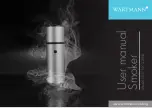
RECOMMENDED LOCATIONS FOR
SMOKE ALARMS
Installing Smoke Alarms in Single-Family Residences
British Standards (BSI) recommend one Smoke Alarm on every floor,
in every living area, and in every bedroom or sleeping area. See “British
Standards (BSI) Recommendations” for details. For additional coverage,
it is recommended that you also install a Smoke Alarm in halls, storage
areas, finished attics and roof voids. Make sure no door or other
obstruction could keep smoke from reaching the Smoke Alarms or
minimize the sound level produced from ensuring the occupants from
hearing the alarm signal.
More specifically, install Smoke Alarms:
•
Where temperatures normally remain between 4˚ C (40˚ F) and 38˚ C
(100˚ F).
•
On every level of your home, including finished attics.
•
Inside every bedroom, especially if people sleep with doors closed.
•
In the hall near every sleeping area. If your home has multiple
sleeping areas, install a unit in each.
•
If a hall is over 7.5 metres (25 feet) long, install an alarm at each end.
•
At the top of the first-to-second floor and subsequent floor
stairways, and at the bottom of the ground floor stairway.
Specific requirements for Smoke Alarm installation may vary from region
to region. Check with your local Fire Brigade and Building Control for
current requirements in your area.
BRITISH STANDARDS (BSI) RECOMMENDATIONS
BS 5839 Part 6 (Code of practice for the design and installation of
fire detection and alarm systems in dwellings)
Smoke Alarms shall be installed in all circulation spaces (normally hall-
ways and staircases) that form part of escape routes, one on every level,
and in all rooms and areas that present a high fire risk. Additionally,
Smoke Alarms should also be installed between the sleeping area(s)
and the most likely sources of fire (living room and kitchen).
If there are long hallways, corridors, or protected rooms or areas over
7.5 metres (25 feet) from the nearest unit, the installation of additional
Smoke Alarms may be necessary. Roof voids containing stored
combustibles or sources of ignition may also warrant the installation of
additional Smoke Alarms.
The installation of Smoke Alarms in kitchens, toilets, bathrooms or
shower rooms is not normally recommended, as these locations
occasionally experience conditions that can result in improper operation.
4
BEDROOM
BEDROOM
HALL
LIVING ROOM
KITCHEN
REQUIRED TO
MEET BSI
RECOMMENDATIONS
RECOMMENDED
FOR ADDITIONAL
PROTECTION
BEDROOM
BEDROOM
KITCHEN
LOUNGE
DINING ROOM
MULTI-STORY RESIDENCE
SINGLE-STORY RESIDENCE, FLAT,
MOBILE HOME
KEY:
EXISTING HOMES
BA
TTER
Y POWERED
LOCATIONS TO AVOID FOR SMOKE ALARMS
For best performance, it is recommended you AVOID installing
Smoke Alarms in these areas:
•
Where combustion particles are produced. Combustion particles
form when something burns. Areas to avoid include kitchens,
garages, and boiler rooms. Keep units at least 3 metres (10 feet)
from the sources of combustion particles (cooker, boiler, space
heater) 6 metres (20 feet) if possible. Ventilate these areas as much
as possible.
Note: If you must install Smoke Alarms closer than
6 metres (20 feet) from a source of combustion particles, keep
the area well ventilated, and the Smoke Alarms clean.
•
In air streams near kitchens. Air currents can draw cooking smoke
into the sensing chamber of a Smoke Alarm near the kitchen.
•
In very damp, humid or steamy areas keep units at least 3 metres
(10 feet) away from bathrooms, toilets, showers, dishwashers, etc.
•
Where the temperatures are regularly below 4˚C (40˚F) or above 38˚C
(100˚F), including unheated buildings, outdoor rooms, porches, or
roof voids.
•
In very dusty, dirty, or greasy areas. Do not install a Smoke Alarm
directly over the cooker. Keep laundry room Smoke Alarms free of
dust or lint.
•
Near fresh air vents, ceiling fans, or in very drafty areas. Drafts can
blow smoke away from the unit, preventing it from reaching the
sensing chamber.
•
In insect infested areas. Insects can clog openings to the sensing
chamber and cause unwanted alarms.
•
Less than 300 mm (12 inches) away from light fittings. Electrical
“noise” can interfere with the sensor; i.e. fluorescent lights, etc.
•
Where the bottom edge of wall mounted Smoke Alarms is placed
below the level of any door opening.
•
In rooms which are being decorated, painted or artexed.
•
In “dead air” spaces. “Dead air” spaces may prevent smoke from
reaching the Smoke Alarm.
Avoiding Dead Air Spaces
“Dead air” spaces may prevent smoke from reaching the Smoke Alarm.
To avoid dead air spaces, follow the installation recommendations
below.
On ceilings,
install Smoke Alarms as close to the centre of the ceiling
as possible. If this is not possible, install the Smoke Alarm at least
300 mm (12 inches) from the wall or corner.
For wall mounting
(if allowed by building regulations), the top edge of
Smoke Alarms should be placed between 150 and 300 mm (6 and 12
inches) from the wall/ceiling line, below typical “dead air” spaces.
On a peaked, gabled, or cathedral ceiling,
install the first Smoke
Alarm within 0.9 metres (3 feet) of the peak of the ceiling, measuring
horizontally. Additional Smoke Alarms may be required depending on
the length, angle, etc. of the ceiling's slope. Refer to BS 5839 Part 6,
5588 Part 1 and local building regulations for details on requirements for
sloped or peaked ceilings.























